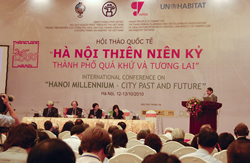The Vietnamese capital Hanoi celebrated its 1,000th birthday last week with much flag waving, dancing, special seminars and one of the biggest parades ever staged in the country.
The main procession started in the capital's historic Ba Dinh Square where the late President Ho Chi Minh declared independence from France 65 years ago. Ho's massive granite mausoleum provided the backdrop for the festivities commemorating King Ly Thai To's decision in the 1010 to move Vietnam's capital 62 miles (100 kilometers) north to Hanoi, then called Thang Long.One of the special conferences, entitled “Hanoi millennium: City Past and Future” on October 12-13 was jointly organized by the People Committee of Hanoi, the Vietnam Urban Planning and Development Association, the University of Hawaii’s Globalization Research Center and UN-HABITAT to discuss the strategies to address urban challenges and to build up Hanoi as a sustainable city in which the cultural aspect is preserved and absorbed in the modernization process. This meeting was a key event for 1000th anniversary and a practical activity to celebrate Word Habitat Day on the theme of “Better city, Better life”. Mr. John Hendra, Resident Coordinator of the United Nations in Vietnam, said Hanoi had two very different urbanization scenarios from which to choose: “In the first scenario the city will fail to meet the needs of its urban citizens. In such a city, many people will live in sub-standard housing and informal settlements, in poorly planned areas where they have little access to basic quality services. Many will end up as migrants, working in the informal economy, and only a minority will be able to realize their productive potential. Such a poorly planned city runs the risk of becoming a dysfunctional metropolitan.” In the second scenario, he said the urban challenges are openly debated in public policy discussions. “The necessary resources for smart urban growth are available, through both public and private investments. This is the kind of city where careful and rational land use planning is in place, as well as good local governance and efficient urban management, improved access to good infrastructure and basic services, and where technology is used to manage environmental stresses. This green, sustainable city is more resilient to natural disasters and creates jobs and opportunities for its residents, provides decent shelter and helps more people out of poverty.” The conference was thus intended to put Hanoi into gear for this second scenario.  |
The conference reviewed many challenges that Hanoi is facing. But in this special time when Hanoi is celebrating its 1000th anniversary, efforts to complete the preparation of the Master Plan for Hanoi up to 2030 become even more necessary. Mr. Daniel Biau, Director, Regional and Technical Cooperation Division, UN-HABITAT, said: “The greatest challenge is to define a vision of sustainable and inclusive development whereby Hanoi becomes a positive reality for everyone, not just for urban planners and managers. As urbanization is to continue, in the future Hanoi should function more effectively as the capital of the country and the engine for regional and national development.”
He said the significant challenges that the new Plan should address include:
- To improve competitiveness not only nationwide but also in the region (Hanoi 2009 provincial competitive index is pretty low – ranked 33 among 63 cities and provinces),
- Development of the other side of the Red River and the Hanoi-Haiphong corridor,
- Provision of housing for the population of a region of about 10 million people by 2030,
- Provision of urban infrastructure and services including well-functioning transportation system, water supply, sanitation, drainage, solid waste collection and treatment, education and health care,
- Potential impacts of climate-related disasters, particularly on the urban poor and the vulnerable groups.
Mr. Biau added: “Hanoi’s planners have to find a fair balance between economic growth and competitiveness of the city on the one hand, and the protection of its natural wealth and built environment on the other”.
The meeting drew participants from the United States, Canada, France, Singapore, China, The Netherlands, Japan and Vietnam. They held thematic panels on The city in Transition, Historic Preservation, Climate Change and Sustainable Urban Development, Migration- Reshaping Architecture and Urbanization, Participatory Planning, Peri-urban Transformation, Livable Cities, Public Space, Transformation, Environment and City Region, which are inter-related aspects that Hanoi can use to guide its future development. |